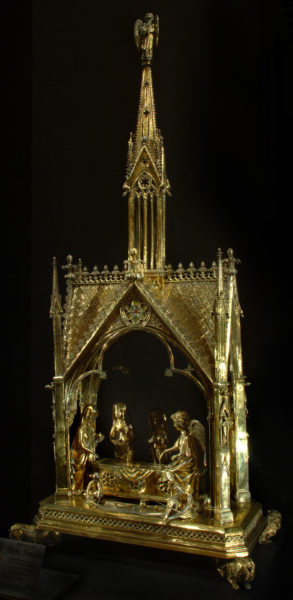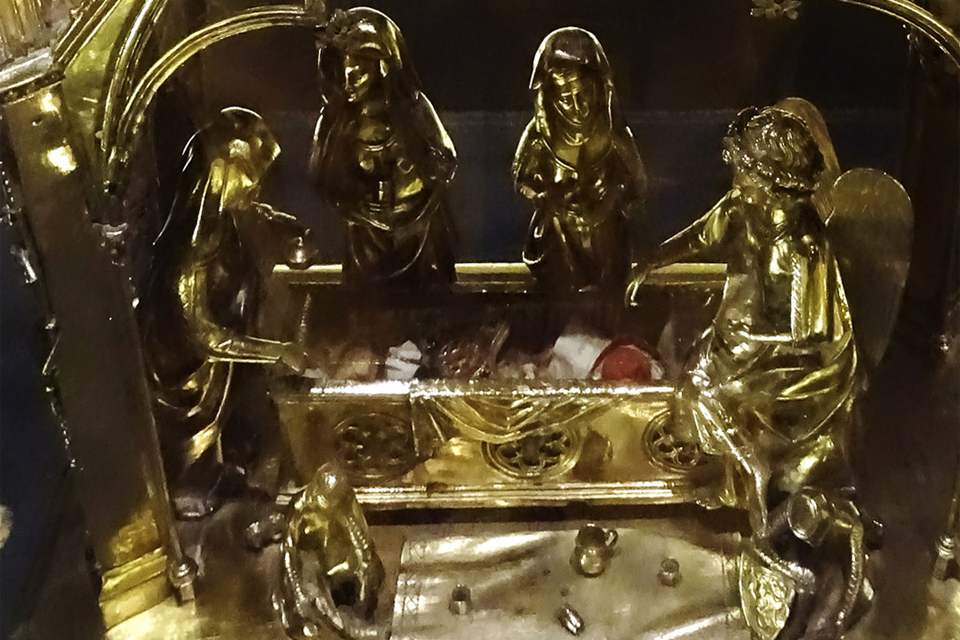In 1993, the contents of the reliquary of the Holy Sepulchre in Pamplona were carefully explored. The following documentation shows that the reliquary is not only unique as a piece of art. It had been fitted with precious and “authentic” relics related to the “empty” tomb.
The reliquary of the Holy Sepulchre in Pamplona belongs together with the Lignum Crucis, to the former royal collection of the crown of Navarre. The reliquary from c. 1255 (1300) takes the form of an open aedicule raised on an oblong platform. It belongs to the arthistorical cathegory: Gothic micro-architecture. Buttresses, topped by pinnacles and cusped arches, flank the four open sides, while the windows are decorated with champlevé enamel. This decorative element may also be found on the sarcophagus in the middle of the tableau, which shows the dramatic scene with the sleeping soldiers, the angel claiming, “he is not here”, and the holy women staring down in horror into the empty grave filled with the sudario, the holy shroud, which John writes, was carefully folded and laid to the side.
And he saw the linen wrappings lying there, and the cloth that had been on Jesus’ head, not lying with the linen wrappings but rolled up in a place by itself. (John 20: 6 – 7).
Apart from the fact that the tableau represents an amalgamation of the “Empty Grave Scenes” from Mark and John, it ads an extra layer. The sarcophagus is fitted with a lid made of rock crystal, through which we together with the holy women may glimpse a gold capsule with what we are told is a fragment of the original sudario – DE SUDARIO DOMINI, we read. We don’t just see the scene, we are carefully invited into the grave participating in the horror and the adoration.
The Pamplona reliquary thus represents a new type of reliquaries, which do not enshrine the holy relics, but rather open them up to let us participate. We become more than just spectators. We get enrolled in the scene with the gesturing figurines replaying inside a temporal sequence the emotional eruption, which the biblical verses only hint at … for terror and amazement had seized them, writes Mark (Mark 16:8).
The Contents of the Reliquary

In 1993 the reliquary was opened in order to register and study the contents. Inside the tiny sarcophagus, three small capsules were found.
The first, a small flat capsule decorated with Gothic openwork, was inscribed with + De Sudario Domino. The second was inscribed with + de Sepulcro Domino, while the last was inscribed with + DE MENSA CENE DOMINI. While the first contained a piece of red linen, the second a small piece of a rock wrapped in linen, while the third contained small pieces of stones. Further the sarcophagus contained a piece of white silk, a piece of linen, fragments of wood, a pebble, a lock of blond hair, small pieces of stained glass, and some red linen wrapping pieces of wood. Also included was a written list explaining the importance of the stones and fragments, all derived from the life and passion of the Lord. These lists are written in a hand form the 16thcentury.
Unfortunately, the exploration of the contents of the sarcophagus did not lead to a camparison of the textile fragments with the alleged Sudario kept in the Cathedral in Orviedo. It would have been nice to know if the tiny fragment had been cut off from that and afterwards placed in its capsule in Pamploma.
The reliquary has traditionally been considered a wedding gift from St. Louis, King of France, to his daughter Isabel in 1255, when she married Theobald II of Navarrea Recently, though, it has been proposed that the reliquary dates from 1284, when Phillipe (a grandson of St. Louis) married Juana de Navarra. The reliquary may have been created as a reflection of the architecture of the Sainte-Chapelle in Paris (1248); as perhaps is also the case with the reliquary of St. Louis, which was donated to St. Domenico in Bologna c. 1300. To a large extent, the two reliquaries may be seen to mirror the same artistic ambition and taste.
SOURCE:
Inventario de las reliquias contenidas en el relicario del Santo Sepulcro de la catedral de Pamplona
By Jesús MaOmeñaca Sanz
In: Príncipe de Viana, (2002) Vol 63, No 226, 2002, pp. 287-294
